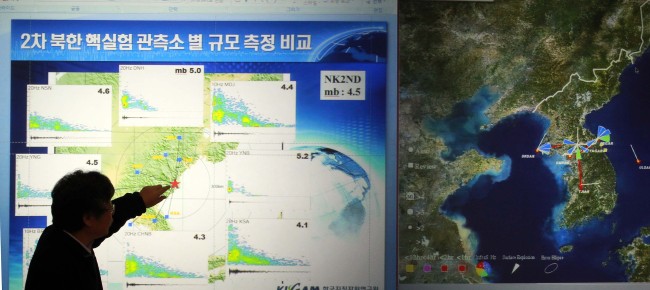S. Korea maintaining careful watch to detect signs of N. Korean nuke test
By Korea HeraldPublished : Jan. 29, 2013 - 20:13
South Korea is maintaining a 24-hour watch to detect the first signs of North Korea conducting another underground nuclear test, official sources said Tuesday.
Sources at the state-run Korea Institute of Geoscience & Mineral Resources said a situation room has been set up at its National Data Center in Daejeon that can receive and process seismic information and relay it immediately to government authorities.
“Our job is to detect the blast and figure out its location and size,” said Chi Heon-cheol, head of the institute’s seismic research office. He said all available personnel has been attached to the situation room.
The institute has an extensive seismic array network around Wonju, 132 kilometers east of Seoul, and detected an “artificial earthquake” about 40 seconds after the North’s May 2009 nuclear test.
Sources at the state-run Korea Institute of Geoscience & Mineral Resources said a situation room has been set up at its National Data Center in Daejeon that can receive and process seismic information and relay it immediately to government authorities.
“Our job is to detect the blast and figure out its location and size,” said Chi Heon-cheol, head of the institute’s seismic research office. He said all available personnel has been attached to the situation room.
The institute has an extensive seismic array network around Wonju, 132 kilometers east of Seoul, and detected an “artificial earthquake” about 40 seconds after the North’s May 2009 nuclear test.

The high state of readiness comes after North Korea denounced the United Nations Security Council resolution condemning its launch of a long-range rocket on Dec. 12. Pyongyang warned Thursday, two days after the resolution was passed, that it will build up its nuclear deterrence and vowed to conduct a “higher level” atomic weapons test aimed at the United States. Over the weekend North Korean media said an atomic test reflected the will of the people, and claimed the country’s leader Kim Jong-un expressed his resolve to take serious action. Kim has been at the helm of the reclusive country since late 2011 after the death of his father Kim Jong-il.
Despite international pressure, Pyongyang detonated its first nuclear device in 2006 and conducted a second test in 2009. Many experts in Seoul predicted that the North may be poised to carry out another test in the coming weeks.
KIGAM, meanwhile, said it processes data not only from the sensors it controls, but those from other organizations such as the Korea Meteorological Administration and the Korea Institute of Nuclear Safety. Insiders said that if the North detonates an atomic device it will be picked up within a minute by earthquake tremor detectors located throughout South Korea, while other sensors can pick up a distinct low frequency sound wave caused by changes in atmospheric pressure from the blast. This sound wave can be picked up within 20 minutes of the test being conducted.
Besides actions being taken by South Korea, overseas media reported that the Preparatory Commission for the Comprehensive Nuclear Test-Ban Treaty Organization under the United Nations, is collecting data from 290 sensor stations around the world in preparation for the possible nuclear test.
Established in 1996, the CTBTO also picked up signs of the North’s two previous atomic weapons tests, and can receive seismic and sound wave data from South Korean sensors. (Yonhap News)
-
Articles by Korea Herald









![[KH Explains] Hyundai-backed Motional’s struggles deepen as Tesla eyes August robotaxi debut](http://res.heraldm.com/phpwas/restmb_idxmake.php?idx=644&simg=/content/image/2024/05/16/20240516050605_0.jpg&u=20240516155018)









